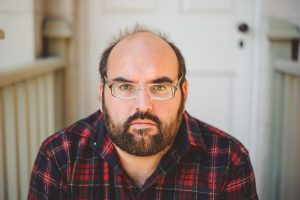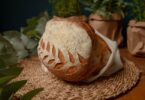Steacy Easton
A few years ago, I went to Boston in November, to give a talk at Harvard about healing and religion, in the context of the Church of Jesus Christ of Latter-day Saints that raised me. The Latter-day Saints grew up in the 19th century in frontier areas, and I was mostly talking about healing rituals, so I spent a lot of time thinking about death, mourning, and my own flesh.
Many women lost children, often in childbirth, in the towns founded by 19th-century Mormons, and there was a theology that occurred around death, that tried to settle questions raised by these deaths. The theology settled into practice sometimes. One of the thoughts early Mormons had was that there was a pre-existence where people gathered waiting to be born, and a kind of post existence where people waited after they had died. Each of these moments was used discussing veils as metaphors—beyond the veil, or the place where the veil was especially transparent, you could see beyond the veil.
One of the ways of seeing beyond the veil was blessings; it was an active political question about who got to do these blessings. Sometimes mothers gave blessings, and the question emerged: how do we systematize these losses, how do we make a proper attempt at officializing those who can see beyond the veil?
I was alone, I was walking through Boston, a city enamoured of its own dead, thinking about what it meant to talk about death, because I had no friends or colleagues in Boston, because of the failure of my own grad program, because I was broke and hungry, and because of the constant walking—any metaphor that I attempted continued to be bodily.
When I am lonely and in a new city, I go to galleries and museums. It feels like walking with a purpose. Maybe I was in a systemizing mood, but in each of the places I visited I saw a metaphor of this veil, of the body reasserting itself, and failing to thrive. Metaphors are often attempts to clean up the mess of the body, to systemize the effluvia and death of desires to live. Boston was rife with failed bodies and failed metaphors.
Boston was wet, grey, bleak. Harvard was mostly red brick. While I was there, I saw art where whiteness was prominent like a scrim over the rest. It reminded me of mourning. What did I see that was mostly white? Some prints by Robert Ryman, but these were late works, and so they were a yellowy cream and a granite tone. Emily Dickinson’s writing paper, which was as white as her dress. A painting in the Boston Museum of Fine Arts, called Butcher Shop, by David Teniers the Younger. An installation, also at Boston’s MFA, by Felix González-Torres, called “Untitled” (Chemo), and a tiny Giotto at the Isabella Stewart Gardner Museum.
There is this centuries-old idea about passing through a veil; of death, like birth, being a returning back through a membrane, body to body. Talking about the Mormon heritage of the idea above does not underestimate other ways of working through the images. The cloth that swaddled the infant Christ, because the cloth that swaddles the Christ laid in the tomb. The women who tended the birth of Christ, and the women who tended the death of Christ—the mopping of the brow, the cleaning up of flesh, bend time into a circle. The flesh and the metaphor of the flesh centre on this act of maintaining bodies.
In Christian myth, we are all bodies of Christ. In Catholic myth (Boston is deeply Catholic), the suffering we endure in our bodies reminds us of the suffering Christ had in His body. Metaphors become concrete.
One of the reasons why I was a bad Christian was that I never believed that Christ’s body returned, and I never believed that our bodies would return like Christ’s body. I could believe in the crucifixion and the wrapping of the body, even the emptiness of the tomb, and the story of Thomas sliding his hand into the side of Christ had enough erotic frisson that I wanted to believe it. But the mystery, and the membrane, and the weird space where he was not quite flesh, made more sense. A friend once said that you could not live in the liminal, you could not camp in a doorway. Another friend asked about my gender, and if I felt dysphoric about it. That November in Boston, the membrane between my body and other bodies felt looser and more transparent, and I recognized that I did not need to be so attached to my body. The awkwardness of it had its own mournful tinge, white on white on white, layered transparencies building into an oblique opaqueness.
Boston, miserable in cold and early winter, made the misery of my own body concrete, my desire to return to other bodies concrete. I was aware of the membrane as the translucent over opaque, body over body, constantly renewing. The membrane is a theatrical scrim, a material reminder of how we cross back and forth, between spaces.
The art that I saw in Boston reminded me of this concrete metaphor. I returned to how we talk about bodies, how we fail to interact with bodies, how bodies are these messy and inconvenient things
From the most metaphorical to the least:
1. Robert Ryman is my favourite painter. I am in love with the narrowness of his vision, and the comprehensiveness of that narrowness. He grew up near Nashville and moved to New York very early. He was entirely self taught, and his work was always about the material culture of painting. He spent his entire career putting something white on something else white: oil on linen or cotton or wood, or one mounted on another, sometimes mounted on a third base; synthetic polymer or gouache on paper; enamel on Bristol board; masking tape, waxed paper; lithographs, aquatint; steel fasteners, hex bolts, aluminum dowels and rods, nails. Sometimes the work had black details, or grey lines, or green edges, or the white was a yellow or a cream. It was an encyclopedia of borders, an anthology of technique.
To me, Ryman is what happens when you try to work out what it means to remember without a body: the forgetting, and replacing, the sorting out and the returning backwards was in his head, unable to be about the flesh. Seeing his work of the early 1960s, before he decided to go forward into all white, and seeing the work from 1990 to 1991, where the edges grew larger, where the colour lapsed, where it was like a shape, was a looping back, an argument for history’s refusal of linearity.
I saw three of these prints in a gallery on Boston’s Newbury Street. (This was a pilgrimage; the gallery had been showing Ryman since the beginning of his career.) The gallery was on the second floor, and I had to go up in a very small elevator. The handsome man who was looking after the show, and the owner of the gallery, asked me what I wanted to see, and I had a laundry list. Two days after I left Boston, the handsome man emailed me photos of everything I saw in person.
I saw three Rymans at that gallery: Light Reflector I, Light Reflector II, and Untitled. The Light Reflectors were from 1990 to 1991; Untitled was from 1993. Untitled was difficult to look at, and pleasant to look at; a puzzle of the problems of visual representation, but smooth as well. An etching is made and an aquatint is placed on top of it. One looks poured into another, liquid firmed up, a hollow filled, an emphasis of form that appears as a correction of form. I think of memory, of erasure, of one positioned over the other. Can we assume biography here? Can we assume a problem of aging, or is this the working of one formal task after another?
Ryman’s Light Reflectors represent the opposite of Paul’s warning to the Corinthians: “For now we see through a glass, darkly; but then face to face: now I know in part; but then shall I know even as also I am known.” This is the light blinding, and then revealing. This is sight that requires acclimatization. This is one box resting on another box, resting on a third, resting on a fourth, with some of the boxes bearing the name of the artist, in his unique loopy hand. What is happening is concealment of a medium, of a methodology, of a construction of light. What is being concealed is the construction of self, and what is being reflected, like a mirror, is an endless recursion. To remember is to mourn, to see through a veil that reasserts its paradoxical concealment and revelation.
This concealment and revelation, through a literal white scrim, continued to be the theme of my trip.
2. Upstairs at the Houghton Library, I looked at a tightly-bound book called a fascicle, which contains Emily Dickinson’s thoughts on ordering individual poems into groupings. This one was the 19th of about 40. In the room behind its case was her writing desk, and books from her family’s library. I could not enter that room, which was roped off. I could not hold the fascicle in my hand; it was too fragile. I could see, though, that she would eliminate a line with an elegant stroke, like her dashes that had curved edges. I thought about seeing and not seeing. I thought about how much Emily Dickinson wrote about white: about her white dress, and how it concealed discussion of heat, or burning, or about propriety; about the instinct of the enclosed body, and the body’s refusal of enclosure. I thought about me being in that space, being refused, and knowing why I was refused. I looked at the grey line of text on the white page on the soft lining of the golden-brown case, and I wanted to touch it, like a relic.
I have never seen Jen Bervin’s work, but she has made giant pieces based on Dickinson’s 19th fascicle. The words are embroidered on taupe muslin. I say words, but they’re really just kinds of marks. These marks are red, and so they are like the words of Jesus in a mid-century bible. After I saw the fascicles, I saw early Book of Mormons, and other Christian texts. Bervin’s work on the 19th fascicle is mostly slight marks, dozens of them: less words and more the ideas of words, like how the word became flesh. This concealing to reveal is central to the problem of the scrim.
3. When the body desires, the body aches; when the body mourns, the body aches.
The overlapping of mourning and desire is the formal feeling Dickinson returns to again and again. I look up the fascicles when I go home for the night, and find myself seeking out what the poet and critic Susan Howe (because she was born in Boston, and her work was largely about, what it means to move between genres, against metaphor). She wrote about Dickinson: “When I love a thing, I want it and I try to get it. Abstraction of the particular from the universal is the entrance into evil. Love, a binding force, is both envy and emulation. HE (the Puritan God) is a realm of mystery and will always remain unknowable, authoritarian, unpredictable. Between revealed will and secret will, Love has been torn in two.”
This is the contradiction of the scrim: what one can see and what is absent from thought. What can be translated, and what is absent from the possibility of translation. The scrim is an act of theatrical mourning, but all mourning in public is an act of theatre. I wonder how public Dickinson is, I wonder about the letters she sent and the edits she constructed, and those elegant S-curved strikethroughs, and I wonder about the woman who wrote: “A Spider sewed/at Night/Without a Light/Upon an arc of /White.”
The Dickinson and the Ryman are abstractions, the scrim suggested but not made explicit. The other works I have been thinking about are more concrete.
4. The Isabella Stewart Gardner Museum had major work stolen in the late 1990s. The frames of those paintings, empty, remembering the crime, are still on the walls of an overcrowded museum. The room with the absent paintings has a tiny Giotto on a desk closest to four Moorish windows.
Before my Boston trip, I had never really thought all that much about Giotto’s work, except to think that it was pleasant. Weeks before my trip, though, I heard the art historian T. J. Clark speak about The Dream of Joachim fresco, which has a gaping black square at its far edge. This black square interrupts the composition and becomes an absence of information, meaning the work has to battle against this absence. Having seen the Ryman, and thinking about Dickinson, I was primed to see Giotto’s work in a new way.
The Giotto in Boston is one of seven, now spread across two continents, which illustrates the life of Christ. This one is tiny, 45.2 x 43.6 centimetres. There are two sets of people on the left, two on the right, and Christ is presented through the middle of composition. The temple is a triangle on top of a rectangle, on top of a square. The rectangle is blank. The square is mostly white, with lines of deep blue that are like writing, or the warp of a garment. The white square of presentation in the Temple functions like the black square in The Dream of Joachim: a spare note of absence. The scene is supposed to be joyful, but the veil across the temple is a foreshadowing of the veil that Christ rips when he is crucified. The curtain rises and lowers. The ritual acts that occur beneath it are ones that we wish to see, and so the absence of information is a kind of formalist pushing of our own ignorance, and the scrim reasserts the violence that is to occur to this body. That Christ is the only one in the middle of composition, that he is being presented, and that he is not hidden by the scrim of white, suggests that the shroud is anticipatory.
The scrim that anticipates mourning in the work of Giotto, one folded carefully into a shape, in order to be unraveled, is the center of the composition. That it is folded carefully, tucked into an altar, that it is made architectural, is part of the act of waiting for use. It is part of the communal waiting for death that marks Christendom, and when I was Christian, my death.
5. The Boston Museum of Fine Arts is next to the Gardner. They have an excellent collection of Dutch old masters, and it is a genre, with their fleshiness, and attention to detail, I have been obsessed with for most of my life. The print maker, curator, and painter, David Teniers the Younger’s was known mostly for genre scenes, and Butcher Shop is one of his most explicit. It was painted in 1642, is oil on panel, and it also has a scrim. It depicts the breaking down of a large bullock. From left to right, one sees the head, shorn of hair, on the table. Underneath that is a basket of horns and hide; the body of the beast is flayed on a wooden stake. There is a wooden widener that prevents cavity collapse about halfway down the painting, through the animal’s ribs. A white napkin is folded over this winder. To the right, behind the carcass, a group of people in blue smocks and white aprons do business. On the far right, a woman carves up bits of the animal’s entrails. There is a basket of fresh meat at her feet. Below the carcass, a dog drinks the blood that has drained from the bull’s flesh.
This is as much of a narrative painting as the Giotto—maybe more so, because Giotto required seven panels to tell his story, and this one tells it in one, with directness. This is how an animal is slaughtered, and how a slaughtered animal is bought and sold. There is work and prosperity in the flesh of this slaughtered animal. The canvas is about the power of colour, except in the centre, where there is blank spot without colour. This is not a napkin that will sop up blood. This small scrim allows for the potential of holiness: the dog as base, the workers as above the baseness, the clean white cloth the potential for something more than base.
Everything about this painting is tense: the stretcher marking the emptied-out cavity of the bull, the napkin that is too small to sop up the blood. Like all those Dutch still-life rabbits that look like descensions, the painting suggests that no matter how much we clean up flesh, the blood and bile return.
In the next room, Emanuel de Witte’s painting The Interior of the Oude Kerk, Amsterdam depicts a dog pissing against the lintel of the titular church. More base than the Tenier, but also a metaphor of how we all fail to contain our bodies.
As someone who is queer, and someone who had spent the week talking about death, and thinking about bodily fluids, and how they contain themselves, this bloody reminder of our own displaced flesh, tightens my heart and deepens my melancholy. Two floors up from the De Witte’s disruptive elegance, and Tenier’s well-constructed failures, there are works that return to the problem of metaphor, a metaphor which is as bodily, which learns from the minimalist aesthetics of people like Ryman.
The Cuban-American artist Félix González-Torres made most of the work in his too-short life about dying. He had AIDS, his lover had AIDS, his circle had AIDS, and his culture had AIDS. Some of the last works of his career—pleasurable, bodily, joyful; a return home against the mourning of death—played on the problems of curtains and scrims.
6. One of those works, González-Torres’s “Untitled” (Chemo), was also at the Boston MFA. It was on one side of a long room. On the other side was Rachel Whiteread’s Double – Doors II (A +B) from 1994. They were cast from the space between doors: the ghosts of entry, literal liminal icons, which fail to provide access. They are not even scrims: they are metaphors for death without returning, which speak about their own inability to speak. González-Torres’s work refutes Whiteread’s (would I think this way, if I hadn’t seen them together?). Chemo is a curtain of white and silver plastic beads. I could not go through it the first time I approached it, nor the second. On the third pass, I grabbed a strand of beads, letting it fall through my hand. I waved my hand across the beads, testing the water. I walked away and returned. I was afraid of something—of becoming dead, of becoming infected, of disrespecting the dead, of ghosts, of desire. I had recently begun having sex again, and the sex was lovely but ineffective. Every time I had sex, the condom reasserted itself, a white latex scrim that would keep me safe. I know that safety, like purity, is an illusion, but González-Torres’s white curtain was real for me, weighted with the symbolism of bodies, reflected like light (literally: some of the beads are small and silver, tiny disco balls, tiny metonymies of hand held pleasure). I walked through, that third time.
7. As Susan Sontag writes: “Illness is the night side of life, a more onerous citizenship. Everyone who is born holds dual citizenship, in the kingdom of the well and in the kingdom of the sick. Although we all prefer to use the good passport, sooner or later each of us is obliged, at least for a spell, to identify ourselves as citizens of that other place.” To enter through González-Torres’s scrim is to enter through the fear of death and infection, through the holiness of desire, without the right passport.
Sontag underestimates how easy it could be to move through the membrane that separates the land of the living from the land of the dead. I wrote in my paper for Harvard about the first wife of the founder of the LDS Church, and how she lost five babies in ten years. Emma Smith influenced Joseph Smith’s cosmology: the conversations about seeing a god of flesh and blood, of seeing not only that god, but the children too, beyond the veil. When Mormons die, the best of them are supposed to pass through that membrane and return to their families, who will also be flesh and blood of a sort that is less abstract than Ryman’s work, more visceral than Dickinson’s, but resembles most closely the domestic of Teniers’s.
8. How do we move back the white scrim? How do we maintain its usefulness as a marker? How do we corrupt its purity? How do we sit in the middle of it, the whiteness reflecting around us like light, a puddle of lost intentions and failures, the fluid of the body and the fluid of the narrative seeking and returning?
 Steacy Easton is a writer and artist living in Hamilton, but grew up in Edmonton. They have written for Spin, the National Post, the Atlantic Online, CNQ, and a number of other publications. They have shown in Toronto, New York, Edmonton, and are the 2020 Martha Street Studio print-maker in residence.
Steacy Easton is a writer and artist living in Hamilton, but grew up in Edmonton. They have written for Spin, the National Post, the Atlantic Online, CNQ, and a number of other publications. They have shown in Toronto, New York, Edmonton, and are the 2020 Martha Street Studio print-maker in residence.






